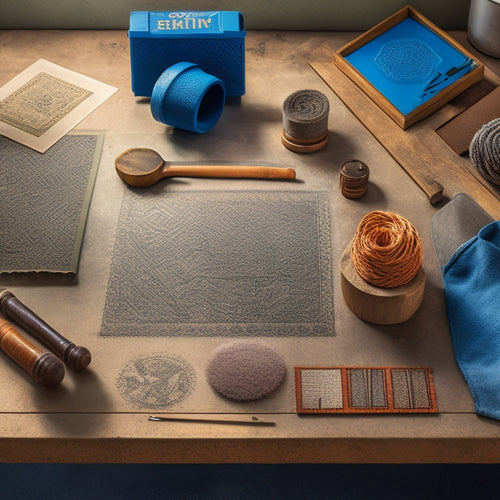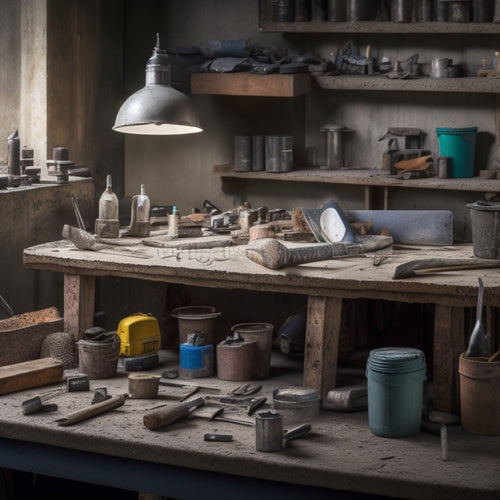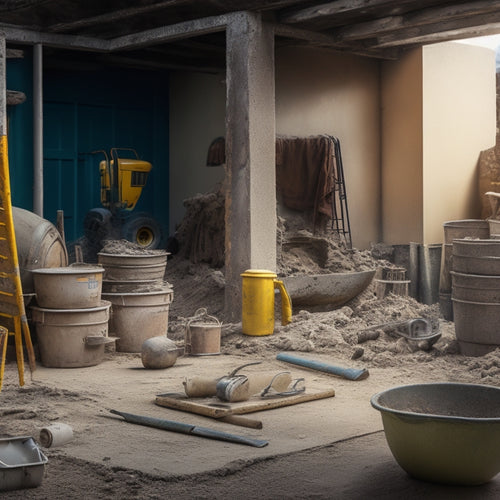
What Tools Do You Need for Concrete Blocks
Share
You'll need a range of specialized tools to successfully lay, finish, and polish concrete blocks. Essential trowels, floats, edging and jointing tools, and block cutting and shaping tools are must-haves. Additionally, concrete finishing and polishing tools, safety equipment, measuring and leveling tools, and cleaning and maintenance essentials are important. From durable trowels and specialized floats to protective gear and precision cutting tools, each item plays a significant role in achieving professional-looking results. With the right tools, you'll be well-equipped to tackle your concrete block project - and by examining the finer details, you'll reveal the secrets to a flawless finish.
Key Takeaways
• Essential trowels for block laying include durable options like stainless steel or high-carbon steel for scooping, spreading, and finishing concrete blocks.
• Floats, such as bull floats, fresno floats, and darby floats, are necessary for achieving smooth, even concrete surfaces with gentle pressure and overlapping circular motions.
• Edging and jointing tools, including jointing trowels and edging trowels, are critical for creating clean, defined edges and corners, and applying and finishing mortar joints.
• Block cutting and shaping tools, such as chisels, splitting tools, scoring and breaking tools, and diamond blades or masonry saws, are required for precise cuts and adjustments.
• Safety equipment, including hard hats, safety glasses, steel-toed boots, and gloves, is essential for protecting against falling objects, dust, debris, and chemical splashes during concrete block work.
Essential Trowels for Block Laying
When laying concrete blocks, you'll need a range of specialized trowels that can handle the unique demands of block laying, including scooping, spreading, and finishing. These trowels are designed to work with the heavy, dense material of concrete blocks, and you'll want to choose trowels made from durable materials like stainless steel or high-carbon steel. The right trowel materials will guarantee your tools can withstand the rigors of block laying.
Mastering various trowel techniques is also vital for successful block laying. You'll need to learn how to hold the trowel at the correct angle, use the right amount of pressure, and develop a smooth, consistent motion. This will help you achieve a professional-looking finish and guarantee the blocks are properly aligned and secured.
With practice, you'll develop the skills and confidence to tackle even the most complex block-laying projects. By selecting the right trowels and honing your trowel techniques, you'll be well on your way to achieving freedom in your concrete block projects.
Floats for Smoothing Concrete Surfaces
As you progress from laying concrete blocks to finishing the surface, you'll need to employ floats to achieve a smooth, even finish. Floats are vital tools for smoothing out concrete surfaces, and there are various types to choose from, including bull floats, fresno floats, and darby floats. Each type is designed for specific applications, so it's important to select the right one for your project.
When it comes to float techniques, you'll need to develop a smooth, consistent motion to achieve an even finish. Start by holding the float at a 45-degree angle and applying gentle pressure. Move the float in overlapping circular motions, working your way across the surface. As you progress, adjust the angle and pressure to achieve the desired finish.
Remember to keep the float clean and well-lubricated to prevent sticking and guarantee a smooth finish. By mastering float techniques and selecting the right float type, you'll be able to achieve a professional-looking finish that's both durable and aesthetically pleasing.
With practice and patience, you'll be able to produce high-quality concrete surfaces that meet your standards.
Edging and Jointing Tools Required
You'll need a range of edging and jointing tools to create clean, defined edges and precise joints in your concrete block construction. These tools are essential for achieving a professional finish and guaranteeing the structural integrity of your project.
Here are the essential edging and jointing tools you'll need:
-
Jointer or Jointing Trowel: For applying and finishing mortar joints, this tool helps create a smooth, even surface.
-
Edger or Edging Trowel: Used for creating clean, defined edges and corners, this tool is a must-have for a professional finish.
-
Joint Sealer or Sealant Applicator: For sealing joints and preventing water ingress, this tool guarantees a watertight seal.
- Mortar Finishing Tool or Float: Used for finishing and smoothing out mortar applications, this tool helps create a uniform surface.
With these edging and jointing tools, you'll be able to achieve precise joints, clean edges, and a professional finish that will last. Remember, the right tools make all the difference in the quality of your concrete block construction.
Block Cutting and Shaping Tools
When you're working with concrete blocks, you'll need to cut them to fit your design or repair requirements.
You'll have to decide on the best block cutting method for your project, which may involve sawing concrete blocks or using other techniques.
Block Cutting Methods
Several block cutting methods are available to shape concrete blocks to fit specific design requirements or repair damaged blocks. As you work with concrete blocks, you'll need to choose the right technique to achieve the desired shape and size.
When it comes to block cutting techniques, you'll want to prioritize safety above all else.
Here are some essential block cutting methods to evaluate:
-
Chiseling: Use a chisel and hammer to remove small amounts of concrete, ideal for making minor adjustments or repairing damaged blocks.
-
Splitting: Apply controlled pressure to split blocks along their natural lines, often used for creating uniform block sizes.
-
Scoring and breaking: Score the block with a specialized tool, then apply pressure to break it along the scored line, suitable for curved or complex cuts.
- Grinding: Employ a grinder or angle grinder to wear down the block, effective for smoothing rough edges or removing excess concrete.
Remember to always follow block cutting safety guidelines, including wearing protective gear, ensuring a stable work environment, and maintaining control over your tools.
Sawing Concrete Blocks
By employing a diamond blade saw or a masonry saw, you can make precise cuts in concrete blocks, achieving clean, straight lines and accurate angles. These saws are designed to handle the hardness of concrete and provide you with the flexibility to make complex cuts with ease.
When it comes to advanced sawing techniques, it's crucial to choose the right cutting blade options for your specific needs. For instance, a diamond blade saw is ideal for making straight cuts, while a masonry saw is better suited for curved or angled cuts.
When selecting a cutting blade, consider the type of concrete you're working with, as well as the desired finish. A blade with a higher diamond concentration will provide a smoother finish, while a blade with a lower concentration is better suited for rougher cuts.
Additionally, consider the blade's arbor size and RPM to guarantee compatibility with your saw. By mastering the art of sawing concrete blocks, you'll be able to release your creativity and bring your vision to life.
With the right tools and techniques, the possibilities are endless, and you'll be free to create structures that are both functional and aesthetically pleasing.
Edging and Smoothing
You'll need to employ edging and smoothing tools, such as block cutters, trowels, and floats, to refine the edges and surfaces of your concrete blocks, ensuring a professional-grade finish that meets your project's specifications.
To achieve the desired edging styles and smoothing techniques, you'll require the following essential tools:
-
Block cutters: for cutting and shaping concrete blocks to precise dimensions.
-
Trowels: for applying and smoothing concrete to achieve a uniform surface.
-
Floats: for flattening and leveling the concrete surface, removing any imperfections.
- Edging tools: for creating clean, defined edges and joints between blocks.
Concrete Finishing and Polishing Tools
As you shift from pouring to finishing, concrete finishing and polishing tools become essential for achieving a smooth, even surface that meets your project's specifications. These tools enable you to refine your concrete blocks, ensuring a professional-looking finish that's both durable and aesthetically pleasing.
When it comes to finishing techniques, you'll need tools like trowels, floats, and edgers to achieve the desired texture and pattern. For instance, a steel trowel is ideal for applying a smooth, even finish, while a float helps to remove excess water and create a level surface. Edgers, on the other hand, are used to create clean, defined edges and joints.
For polishing methods, you'll require specialized tools like polishing pads, grinding blocks, and diamond abrasives. These tools help to remove imperfections, scratches, and blemishes, leaving your concrete blocks with a high-gloss finish.
Safety Equipment for Block Handling
When handling concrete blocks, you'll need to prioritize your safety above all else.
You must wear essential protective gear, such as hard hats, safety glasses, and steel-toed boots, to prevent injuries from falling blocks or debris.
Protective Gear Essentials
Handling concrete blocks requires wearing essential protective gear to prevent injuries from heavy lifting, sharp edges, and falling objects.
As you work with concrete blocks, you need to prioritize your safety above all else. Wearing the right protective gear is vital to meeting safety standards and ensuring your freedom to work without worrying about injuries.
Here are the essential protective gear you must wear:
-
Hard hat: Protects your head from falling objects and debris.
-
Safety glasses: Guards your eyes from dust, debris, and chemical splashes.
-
Steel-toed boots: Safeguards your feet from heavy blocks and sharp edges.
- Gloves: Provides grip and protection for your hands from rough surfaces and heavy lifting.
Hazard Prevention Measures
By implementing hazard prevention measures, you can considerably reduce the risk of accidents and injuries associated with concrete block handling.
Conducting a thorough hazard assessment is essential to identifying potential risks and developing effective risk mitigation strategies. This involves evaluating the workplace, equipment, and tasks involved in block handling to pinpoint potential hazards.
You should also invest in safety equipment specifically designed for block handling, such as gloves, safety glasses, and steel-toed boots. These will provide you with protection against cuts, abrasions, and impact injuries.
Additionally, consider implementing ergonomic measures to reduce the physical strain of lifting and handling blocks. This may include using block carts, dollies, or pulleys to minimize manual handling.
Measuring and Leveling Tools Needed
You'll need a set of essential measuring and leveling tools to guarantee accuracy and precision in your concrete block projects. These tools will help you achieve professional results and avoid costly mistakes.
Measuring techniques are vital in concrete block construction, as even slight deviations can affect the entire structure. To confirm leveling accuracy, you'll need the following tools:
-
Laser level: This tool projects a level line or dot onto the surface, enabling you to check the accuracy of your work.
-
Spirit level: A classic tool that indicates whether a surface is perfectly horizontal or vertical.
-
Measuring tape: A flexible tape measure that allows you to take precise measurements of your blocks and the area where they'll be laid.
- String and stakes: A simple yet effective tool for creating a straight line or establishing a reference point for your blocks.
Cleaning and Maintenance Essentials
Four essential cleaning and maintenance tools are required to keep your equipment and workspace in prime condition during concrete block projects.
You'll need a wire brush to remove excess concrete from your tools and a bucket with warm water and mild detergent to clean your mixing equipment. A pressure washer is also necessary to remove stubborn concrete residue from your workspace. Additionally, a broom and dustpan will help you sweep away debris and dust.
Developing effective cleaning techniques is vital to maintaining your tools and equipment.
Set aside time each day to clean your tools and equipment, and schedule regular maintenance checks to guarantee everything is in good working order. Create a maintenance schedule to stay on track and avoid costly repairs down the line.
By incorporating these tools and techniques into your workflow, you'll be able to work efficiently and effectively, without worrying about equipment failures or safety hazards.
Frequently Asked Questions
Can I Use a Regular Hammer for Tapping Concrete Blocks Into Place?
You can't use a regular hammer for tapping concrete blocks into place; instead, opt for a rubber mallet or tamping tool to prevent damage, and employ gentle tapping techniques to guarantee precise alignment.
What Is the Best Way to Store Concrete Blocks to Prevent Damage?
'A million concrete blocks could come crashing down if you don't store them properly! You'll need to invest in sturdy storage solutions, like pallets or block racks, to guarantee block protection and prevent damage from the elements or accidental knocks.'
Do I Need to Seal Concrete Blocks After Laying Them?
You'll want to contemplate sealing your concrete blocks after laying them to enhance block durability; explore various sealing methods, such as silane or siloxane-based treatments, to protect your blocks from the elements and guarantee long-term freedom from maintenance.
How Do I Remove Excess Mortar From Concrete Blocks?
When removing excess mortar from concrete blocks, you'll want to utilize effective mortar removal techniques, employing specialized cleaning tools like stiff-bristled brushes, wire scrubbers, or joint rakes to scrape away excess mortar without damaging the blocks.
Can I Use Concrete Blocks for Building a Retaining Wall?
You can use concrete blocks for building a retaining wall, but make certain you've mastered block stacking techniques and create a solid retaining wall design, considering factors like drainage, soil pressure, and structural integrity.
Conclusion
You've made it to the finish line!
You're now equipped with an arsenal of tools to tackle even the most demanding concrete block projects. From trowels to polishing tools, you've got the ultimate arsenal to craft masterpieces that'll last for centuries.
With these essentials, you'll be constructing structures that'll defy gravity, withstand earthquakes, and make the ancient Egyptians jealous!
Get ready to release your inner mason and create concrete wonders that'll leave the world in awe.
Related Posts
-

5 Best Tools for Stamping Concrete Walls
When it comes to stamping concrete walls, you'll need a range of specialized tools to achieve the desired texture and...
-

Top Tools for Concrete Repair Success
When it comes to concrete repair success, you'll need a well-stocked toolkit with essential hand tools like trowels, ...
-

What Tools Are Needed for Concrete Wall Foundations
You'll need a thorough array of tools and equipment to construct a concrete wall foundation that meets structural int...


